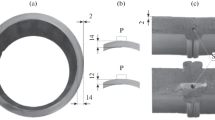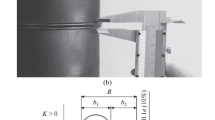Abstract
The simulations and reliability evaluations were utilized to determine whether the automated ultrasonic testing (AUT) technology was appropriate for evaluating semi-automatically welded oil and gas pipeline joints. The simulations found how the AUT technology was affected by beam coverage at the groove and in the volume channels, the time-of-flight diffraction (TOFD) surface dead zone, the root detection angle, the weld groove angle, and welding line deviations at the weld groove fusion. Detailed analysis of large datasets identified the distribution of defects that resulted from semi-automatic welding. Then, a model was proposed that evaluated the reliability of the AUT technology in examining semi-automatic welding. The corresponding results indicated that the technology could detect most defects in semi-automatically welded joints. The critical heights of the defects in the thermal welding zone and at the groove were less than 1.2 mm at a confidence level of 95% and a percentage of defects (PODs) of 90%. This supported the hypothesis that the AUT technology could identify defects resulting from semi-automatically welded oil and gas pipelines. During actual testing, rationally optimized AUT technology detected all forms of semi-automatic welding defects to meet the reliability requirements. The testing process has certain requirements for the quality of the grooves in the semi-automatically welded joints. Specifically, variation of the groove angle should not exceed ± 2.5°, and the horizontal offset of the groove should be within ± 4 mm. Similarly, for the incomplete root fusion of semi-automatic welding, the root should be covered with an incident angle as small as possible, and wave beams of 60° or greater should be avoided.









Similar content being viewed by others
Availability of data and material
The data used to support the findings of this study are included within the article.
References
Weihe HU, Honglong ZH, Mingfei LI (2019) Development history and prospect of oil & gas storage and transportation industry in China. Oil Gas Stor Transport 38(1):pp 1–11
XU B (2009) Present situation of safety in storage and transportation of dangerous chemicals. J Chem Indus Eng 30(2):pp 47–50
American Society for Testing and Materials (2011) Practice for mechanized ultrasonic examination of girth welds using zonal discrimination with focused search units: ASTM E1961–2011[S]. American Society for Testing and Materials, Conshohocken, pp 1–14
Ssmta B, Jmpb C, Lfn C et al (2021) Microstructural characterization and nondestructive testing and of welded joints of duplex stainless steel in flexible pipes[J]. J Market Res 15:3399–3408
Bologna F, Tannous M, Romano D, Stefanini C (2022) Automatic welding imperfections detection in a smart factory via 2-D laser scanner[J]. J Manuf Process 73:948–960
Carvalho AA, Rebello J, Souza M et al (2008) Reliability of nondestructive test techniques in the inspection of pipelines used in the oil industry[J]. Int J Press Vessels Pip 85(11):745–751
Javadi Y, Mohseni E, Macleod CN et al (2020) Continuous monitoring of an intentionally-manufactured crack using an automated welding and in-process inspection system[J]. Mater Des 108655
American Petroleum Institute (2013) Welding of pipelines and related facilities: API 1104–2013[S]. American Petroleum Institute, Washington, p 65
Det Norske Veritas (2010) Pipe girth weld AUT system qualification and project specific procedure validation: DNV-RP-F118–2010[S]. Oslo: Norway Classifi Soc 5
Canadian Standards Association (2015) Oil & gas pipelines: CSA Z 662–2015[S]. Mississauga: Canad Stand Assoc 150–153
SUI Y (2014) High strength line-pipe girth welding technology of oil and gas transmission pipeline. Elect Weld Mach 44(5):pp 27–32
GB/T50369 (2014) Code for construction and acceptance of oil and gas long-distance transmission pipeline engineering[S]
Hu Y, Wu Q, Niu H et al (2018) Reliability evaluation of automatic ultrasonic testing (AUT) technology of pipeline with automatically welded girth welds[J]. Petroleum engineering construction 44(3):58–60
Li Y (2014) Initial exploration on the reliability of phased array ultrasonic testing and numerical simulation of POD. Dalian. Dalian University of Technology
Hu Y, Wang Y, Zhou J et al (2016) Research on ultrasonic testing reliability evaluation for land long-distance pipeline with automatic welding joints. Petroleum engineering construction 42(5):85–89
Zhan J (2010) Research on the acoustic field calculation and inspection reliability of ultrasonic test. Wuhan. Wuhan University
Feng Z, Li Z (2010) The reliability-based method to estimate POD of crack. Non-destructive testing 32(4):pp 249–252
LI G (2010) Application of automatic ultrasonic inspection in the construction of west pipeline. Oil-gas field surface engineering 29(8):pp 92–93
Nath SK (2014) Effect of variation in signal amplitude and transit time on reliability analysis of ultrasonic time of flight diffraction characterization of vertical and inclined cracks. Ultrasonics 54(3):pp 938–952
Yusa N, Knopp JS (2016) Evaluation of probability of detection (POD) studies with multiple explanatory variables[J]. J Nucl Sci technol 53(4):pp 574–579
Li M, Nakagawa N, Larson BF, Meeker WQ (2013) Statistical assessment of probability of detection for automated eddy current nondestructive evaluation inspection. Res Nondestruct Eval 24(2):pp 89–104
Funding
This paper is supported and funded by programs with Fundamental Research Funds for the Central Public Welfare Research Institutes (Grant no. TKS 20200320, TKS 20200316).
Author information
Authors and Affiliations
Corresponding author
Ethics declarations
Ethics approval and consent to participate
Not applicable.
Consent for publication
Not applicable.
Competing interests
The authors declare no competing interests.
Additional information
Publisher's Note
Springer Nature remains neutral with regard to jurisdictional claims in published maps and institutional affiliations.
Rights and permissions
About this article
Cite this article
HU, Y., LU, L. & ZHAN, S. Simulation and reliability evaluation of automated ultrasonic testing technology in semi-automatic welding of oil and gas pipelines. Int J Adv Manuf Technol 124, 4131–4141 (2023). https://doi.org/10.1007/s00170-022-09202-3
Received:
Accepted:
Published:
Issue Date:
DOI: https://doi.org/10.1007/s00170-022-09202-3




